More beach reading! DC? Marvel? How about Lancer, Signet and Bantam…
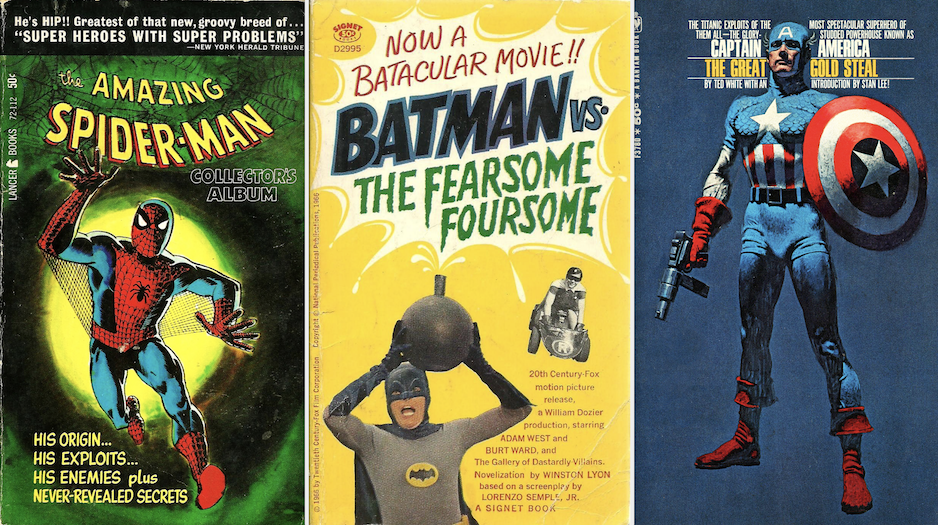
—
UPDATED 7/25/23: It’s summertime — so here’s some more beach reading for ya! This piece first ran in October 2020, when Paul Kupperberg was first joining 13th Dimension. Dig it! — Dan
—
Hey, our new best friend Paul Kupperberg — veteran writer of everything — is back with another tour of ’60s comics kitsch and cool.
His upcoming memoir/writer’s guide I Never Write for the Money… But I Always Turn in the Manuscript for a Check has already been funded on Kickstarter, and this is his fourth guest appearance here at 13th Dimension in the last four weeks.
This time out he’s looking not at comic books per se — but books tied to the art form.
So dig Paul’s 13 FAVORITE 1960s COMIC BOOK BOOKS:
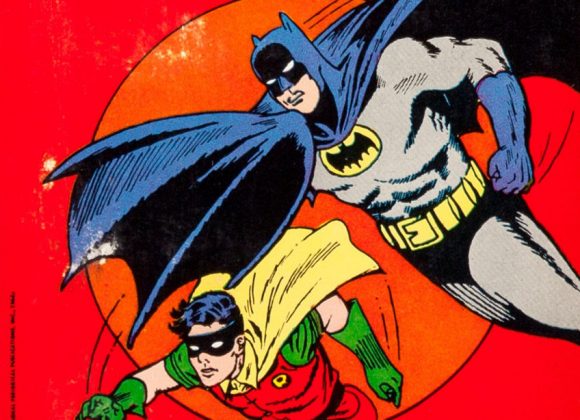
By PAUL KUPPERBERG
I am a member of the International Association of Media Tie-in Writers (IAMTW) and a proud writer of books and short stories based on OPIP (other people’s intellectual properties). In addition to all the comic books I’ve written, I’m also the author of Spider-Man: Crime Campaign and Spider-Man and the Hulk: Murder Moon (Pocket Books, 1979), Kevin (based on the Archie Comics character and winner of the 2014 IAMTW Scribe Award for Best Young Adult Novel and GLAAD Award nominee, Grosset & Dunlap, 2014), Wishbone Mysteries: The Sirian Conspiracy (co-authored with Michael Jan Friedman, Big Red Chair Books, 1999), Powerpuff Girls: Buttercup’s Terrible Temper Tantrums — Pick a Powerpuff Adventure (Scholastic, 2002), Mad Libs featuring Betty and Veronica, ther Avengers, and DC superheroes (Grosset & Dunlap), and JSA: Ragnarok (Crazy 8 Press 2020), as well as chapter books starring Superman, Batman and Wonder Woman, and short stories for anthologies featuring Batman, Star Trek, Dr. Who, the Avenger, Green Hornet, Lone Ranger, Kolchak: The Night Stalker, and others.
My love for superhero prose and paperback reprints dates back almost as far as my love for the comic books these books are based on. So here are MY 13 FAVORITE 1960S COMIC BOOK BOOKS:
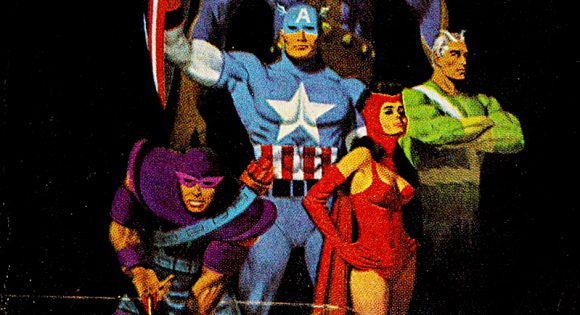
—
1. The Great Comic Book Heroes: The Origins and Early Adventures of the Classic Super-Heroes of the Comic Books, in Glorious Color, by Jules Feiffer (Bonanza Books, 1965). The single greatest tome about the Golden Age of Comics ever published. Fight me! Seriously, cartoonist/author/playwright Jules Feiffer’s coffee-table book not only reprinted key Golden Age stories at a time when such reprints, even in the comics themselves, were few and far between, but it contained Feiffer’s lyrical introduction, his love note, his ode to the Golden Age comics of his childhood and his early experiences in that world as a fledging artist and assistant to Will Eisner on The Spirit.
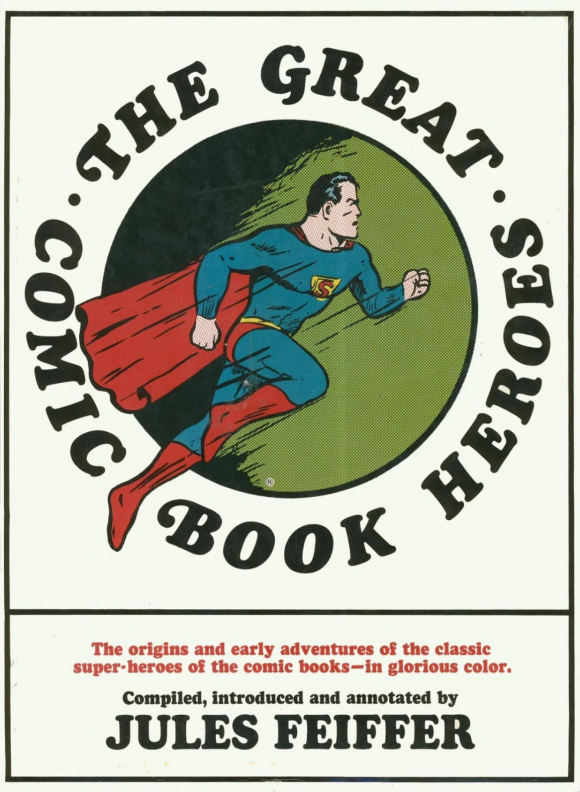
This was the first place I ever saw a Spirit or Plastic Man story, in addition to the (mostly origin) stories of Superman, Batman, Captain Marvel, Human Torch, Flash, Green Lantern, Spectre, Hawkman, Wonder Woman, Sub-Mariner and Captain America. My friend Steve and I took turns checking The Great Comic Book Heroes out of the library for months, until one of us could finally afford a copy of our own. Fantagraphics issued a reprint of just Feiffer’s essay from the book, a memoir still worth reading.
—
2. Batman vs. 3 Villains of Doom, by Winston Lyon (Signet, 1967). With the success of the Batman TV series that had debuted in 1966, a pair of novelizations made it to print while the show was still hot. The first was Batman Vs. the Three Villains of Doom by William Woolfolk under the pen name Winston Lyon.
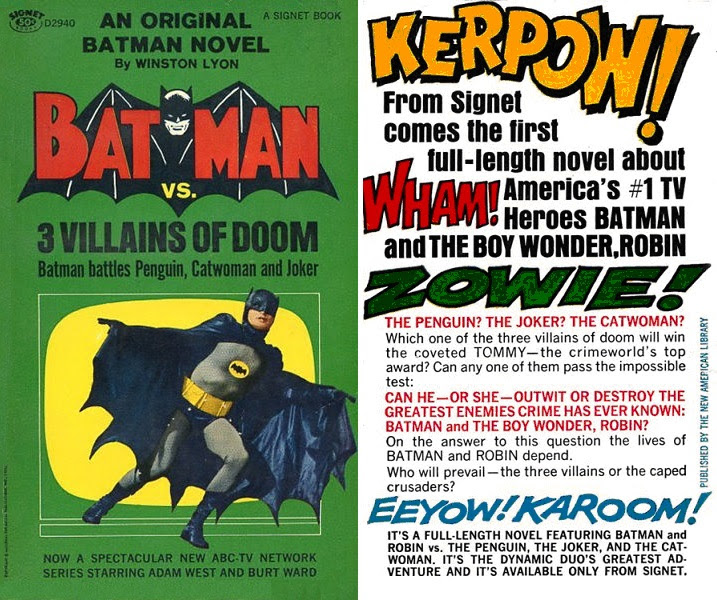
By this point in his career, Woolfolk had left his career as a comic book writer for DC behind for novels, films and TV, but he knew the comic book Batman, and was obviously given access to at least some TV scripts, resulting a pleasant blend of the two worlds. The plot pits Joker, Penguin and Catwoman against one another in a super-villain Olympics to get Batman, and seesaws between the grim and the humorous. It was the first prose treatment of a comic book character I had ever read, even before Big Little Books. The concept, if not the execution, took my breath away.
—
3. Batman vs. the Fearsome Foursome, by Winston Lyon (Signet, 1966). An all-out camp cover treatment announced the tone of the novelization of the 1966 Batman theatrical movie, highlighting one of the most absurd moments in a film full of absurd moments (“Some days, you just can’t get rid of a bomb!”) and declaring it was “Now a Batacular Movie!!”
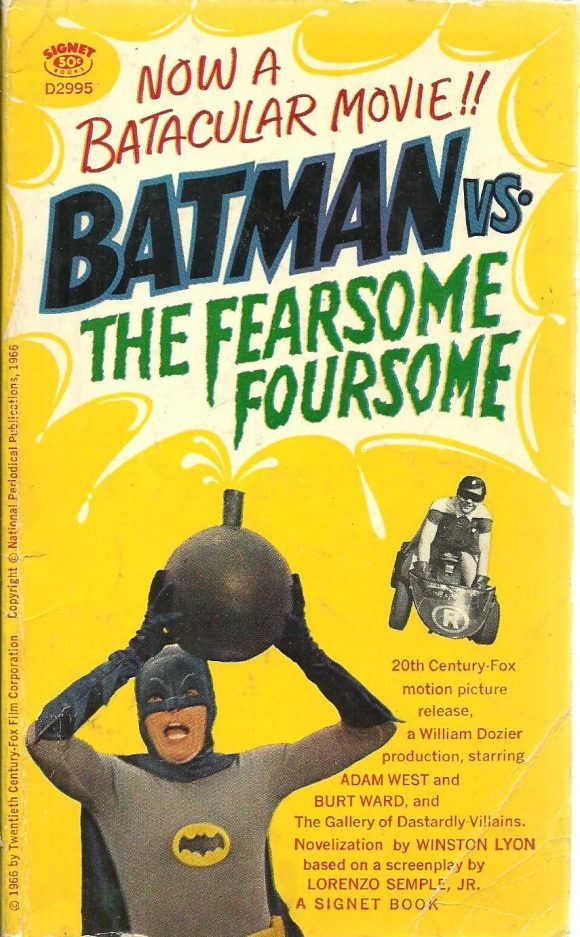
In the last few years, I’ve had the opportunity to write articles dissecting and analyzing episodes from the first two seasons of Batman and found that when you open them up for inspection, they’re pretty much empty. Their spindly plots were mainly there to hold up a series of ongoing bits (“Holy, (fill-in-the-blank), Batman!”, Batman’s pompous mini-lectures, the pop-out guest-star from the window while they were climbing up a wall, the unveiling of some new piece of Bat-equipment, etc.) and go through a series of puns while the heroes run in usually pointless circles based on inane clues. Lorenzo Semple Jr.’s screenplay was, fortunately, a bit beefier than that, but the absurd still outweighed the rest.
—
4. Captain America and the Great Gold Steal, by Ted White (Bantam, 1968). On the other hand, it was the execution that I found breathtaking on Captain America and the Great Gold Steal. One-time science fiction and comic book fan Ted White had made the leap to professional and by the time he wrote The Great Gold Steal, he was already a Hugo-nominated author and respected science-fiction editor.
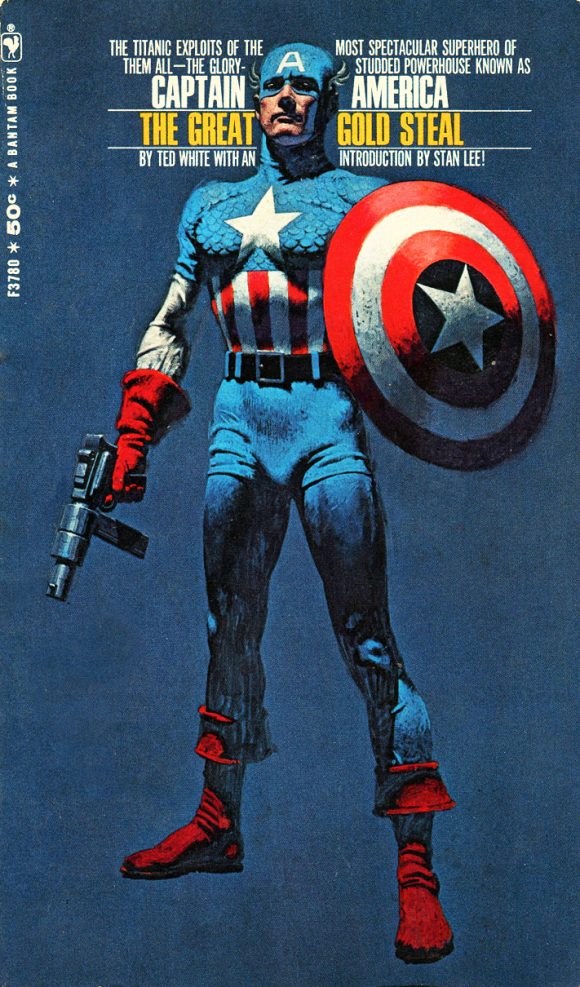
The story revolves around Cap’s efforts to prevent a (spoilers!) great gold steal and White keeps things moving along at a crisp pace, but what stands out in my memory is his retelling and expanding on Steve Roger’s background and the details of his origin from the few brief panels we usually saw in the comics. Actually, what really stood out for me was the fact that just because something was based on a comic book, it didn’t have to treated like it was for 8-year-olds. Oh, and the cover by Mitchell Hooks was — and remains — awesome.
—
5. The MAD Reader; MAD Strikes Back; Inside MAD; Utterly MAD; The Brothers MAD; The Bedside MAD, etc., etc., so on and so forth (Ballantine Books, 1954 – 1993). Starting in 1954, Ballantine published a series of 93 black-and-white paperbacks of material from MAD. I grew up in a house blessed with a complete set of MAD Magazines (older cousins had passed their collection on to us), but the original 23 10-cent color comic book format issues of MAD were unknown to me.
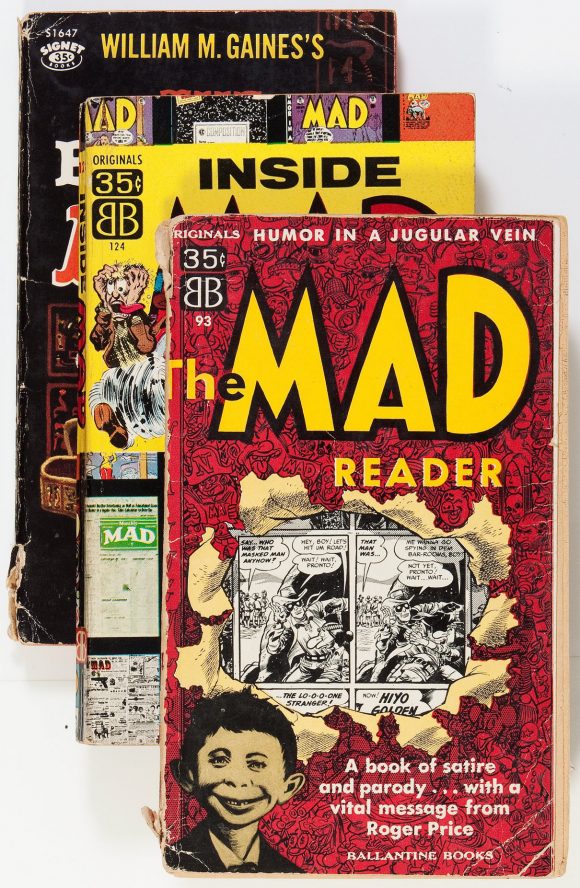
There were about two dozen MAD books on the stands by the time I found them (publisher Bill Gaines saw to it that they were kept in print with new editions issued every few years), but it was the first seven or eight books, reprinting those dead-on comics format satires by Will Elder and his brilliant crew of MAD-men that were revelatory to me. Fifteen years later, writing movie satires for Marvel’s Crazy, I found myself paying repeated homage to those stories almost to the point of plagiarism. It would also be my thrill to be the editor at DC working with iBooks in preparing the 2002 50th anniversary editions of those very same books.
—
6. Batman/Batman vs. the Joker /Batman vs. the Penguin (Signet Books, 1966). Yes, we had the 80-Page Giants reprinting a ton of tales from the previous decade of DC’s top-tier heroes (see my earlier 13 FAVORITE 1960s DC 80-PAGE GIANTS), but we didn’t have any opportunities to see those stories in black and white.
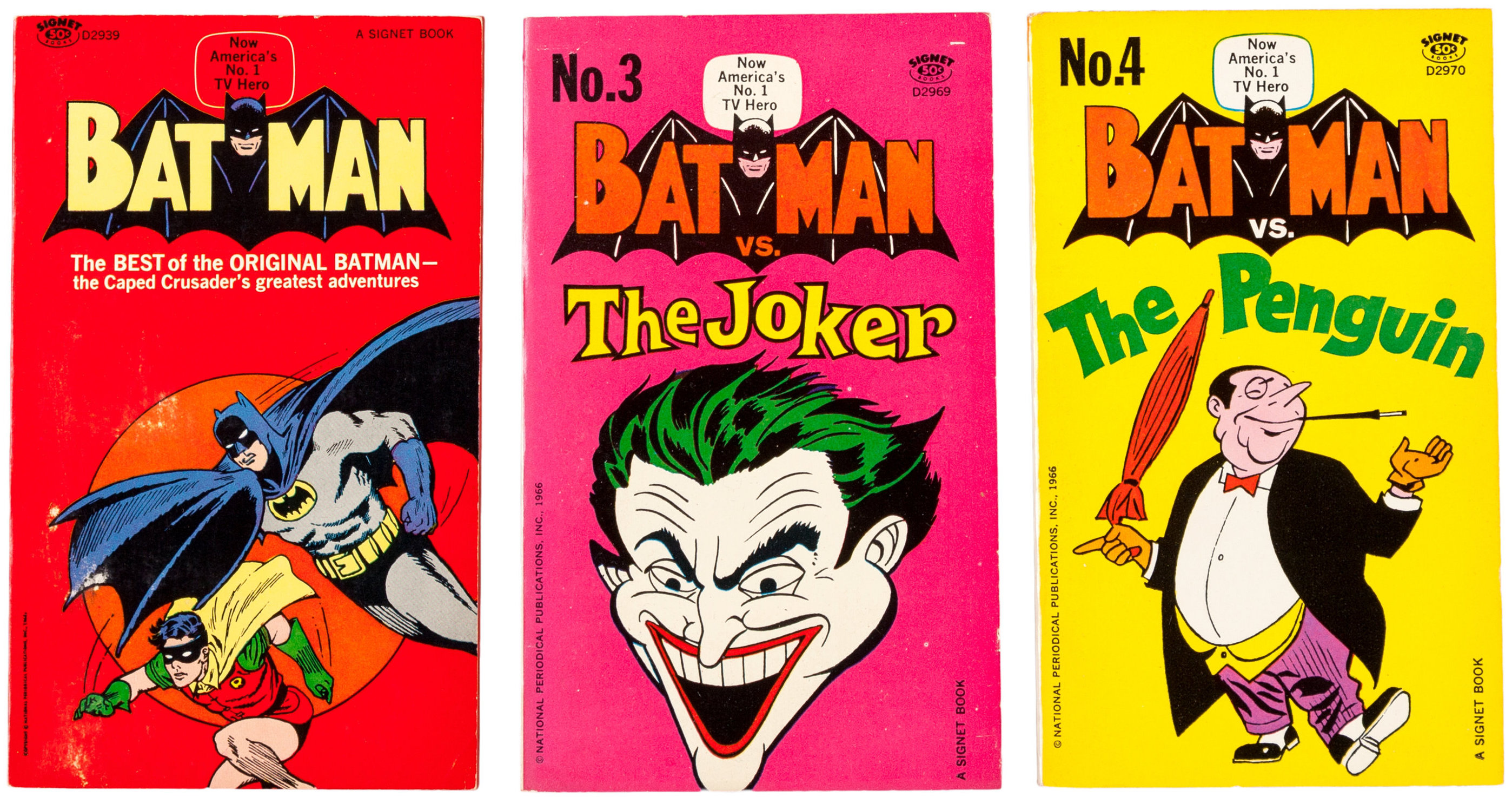
Thanks again to the triumph of the first season of Batman, Signet’s publishing agreement with DC gave us not only the two Batman novels, but a trio of paperback reprints as well, the panels cut up and rearranged for the smaller paperback book page and printed, as noted, in black and white. Don’t ask me why, but the format somehow made these reprints feel different than their earlier four-color reproductions. Maybe it was just the fact that we were reading them in an actual book instead of a flimsy comic… not that the format was any help for the sixth Signet book in their DC/Batman program, Larry Adler’s Funniest Fan Letters to Batman. That one never made it into my collection.
—
7. High Camp Super-Heroes (Belmont Books, 1966). There’s something desperate about this black-and-white collection of stories from Archie Comics’ Mighty Heroes that jumped into the superhero/Batman/camp craze. “DiG (lettered to look like “DC”) their crazy costume s– Marvel at their stupor deeds”; there’s even a mention of Superman, associating themselves with the big boy!
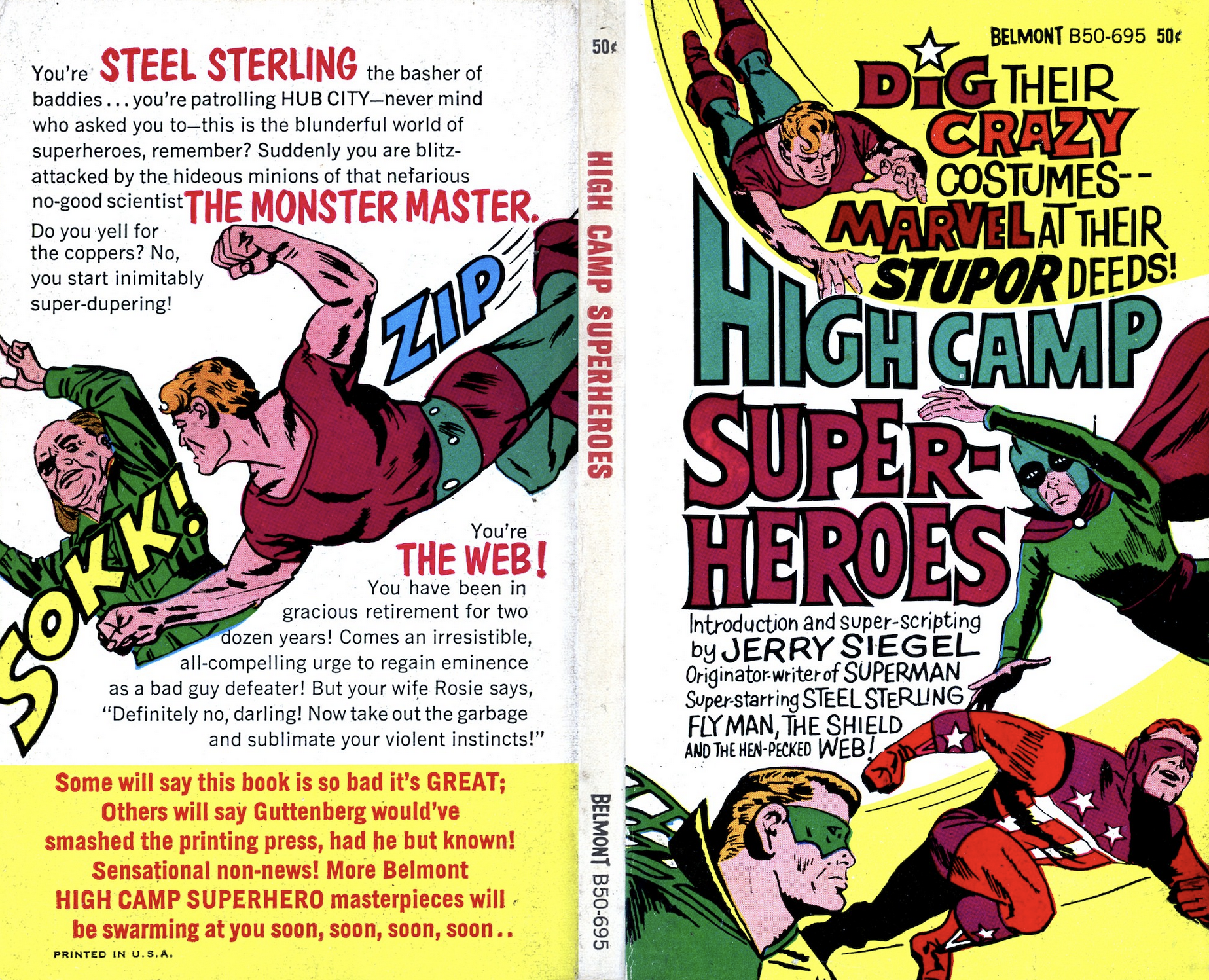
I knew even as I was reading these stories by writer Jerry Siegel (aka Superman’s co-creator) and artist Paul Reinman starring revivals of the Golden Age MLJ Comics characters such as Steel Sterling, the Shield and the Web that they were not good. Siegel was long past his prime, trying to write for a market he didn’t understand, and Reinman, truth be told and as much as I love his art, had never really had one, but 11-year-old me loved these stories, and they were my first exposure to what were otherwise great characters, some of whom I’d get my hands on as editor or writer for DC’s 1990s Impact Comics line.
—
8. Captain Nice, by William Johnston (Tempo, 1967). I read a lot of TV novelizations in the 1960s and there were plenty to choose from, from The Flying Nun to Dr. Kildare to The Man from U.N.C.L.E. to Get Smart (one of the series of which was confiscated by Mrs. Siegel in the 5th grade because she didn’t think it was proper reading material). One of my favorites, though hardly the best, was Captain Nice, based on an NBC one-season sitcom created by Buck Henry, starring William Daniels, Ann Prentice and Alice Ghostley that debuted almost exactly one year after ABC’s Batman. (Mister Terrific, CBS’ entry in the half-hour superhero sitcom sweepstakes premiered the same night as Captain Nice; neither made it to a second season).
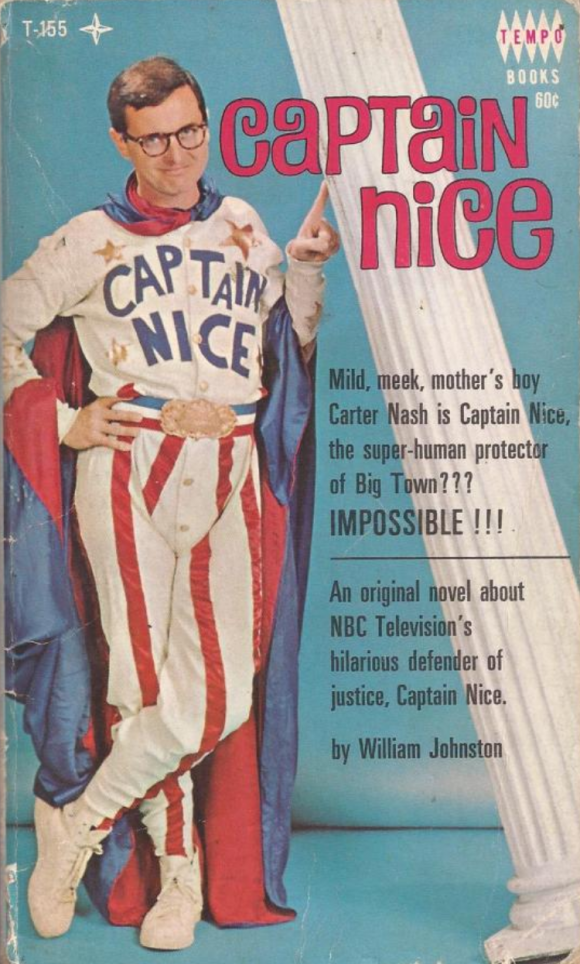
Carter Nash was a nebbish chemist who developed a concoction that gave him superpowers and had an overbearing mother. That seemed to be all uber-prolific novelization writer William Johnston had to work with before he churned this one out, but it was a superhero (sort of) in prose (sort of), and that was enough for me.
—
9. The Green Hornet in The Infernal Light, by Ed Friend (Dell, 1966). William Dozier had done it with Batman, so ABC had him take a run at another classic costumed crimefighter, the Green Hornet. Created in 1936 for the radio, Green Hornet and his sidekick Kato found their way to comic books and movie serials in the 1940s, as well as in a quartet of Whitman’s Big Little Books, credited to creator Fran Striker. But they were new to me when they hit the airwaves in September 1966 (played by Van Williams and Bruce Lee) nine months after Batman’s triumphant debut. Ed Friend (pseudonym of pulp writer Richard Edward Wormser) concocted some vague story that had the heroes in hot but largely pointless pursuit of a bad guy and a world-conquering lightbulb.
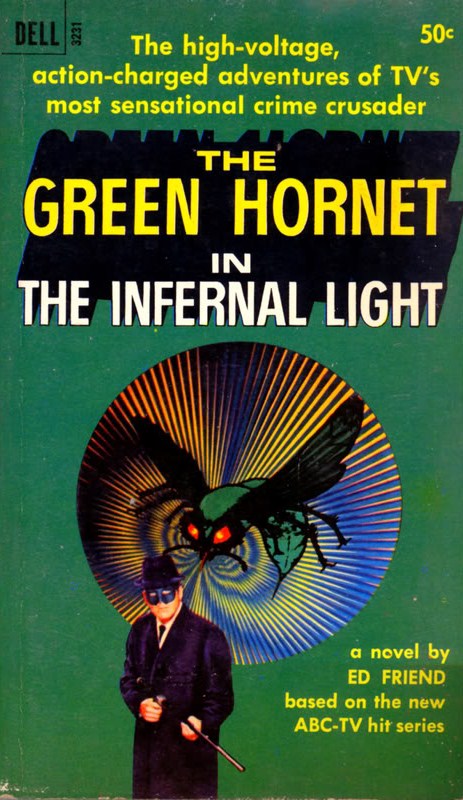
“Based on the new ABC-TV hit series,” The Infernal Light reads like a hastily written media tie-in; it’s sparsely plotted (to say the least), more or less resembles the show it’s based on, pushing camp and cliché over character to keep things moving.
—
10. The Avengers Battle the Earth-Wrecker, by Otto Binder (Bantam 1967). I gave this book, Marvel’s first foray into superhero prose fiction, higher marks as a 12-year old reader than I did when I reread it a decade later, but The Avengers Battle the Earth-Wrecker is a bit of a slog. Despite being written by veteran comic-book writer and science-fiction author Otto Binder, the story pitting them against Kang the Conqueror wannabe Karzz the Conqueror, a 70th century time traveler seeking retribution for creation of later Earth-destroying weapons never really seemed to gain traction and catch on.
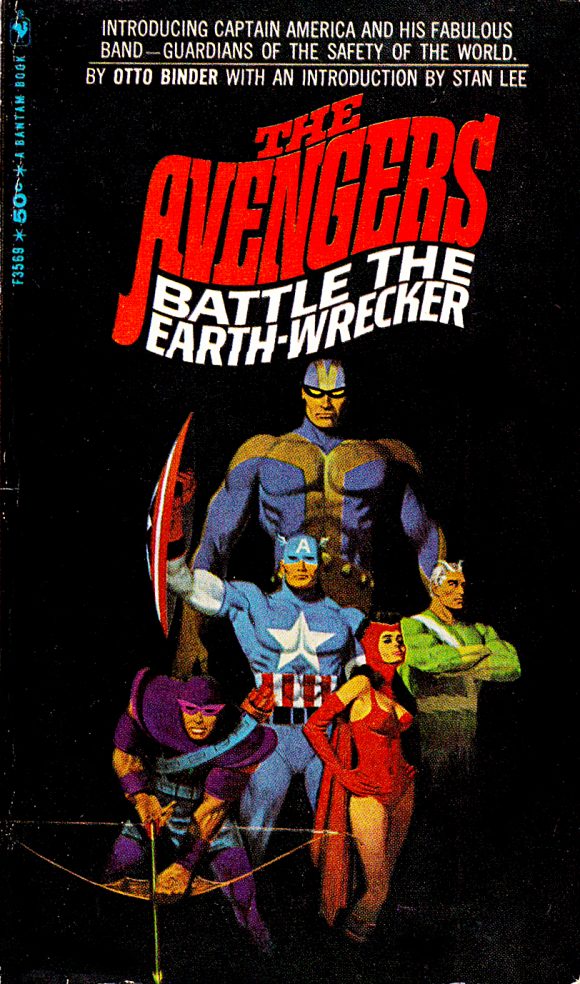
The opening chapters revealing, tediously and one-by-one, the origins of the Avengers team members to a TV audience, are a clumsy, plodding indication of what’s to come in this slim volume. Still, the stunning Robert McGinnis cover that made me lurch for the spinner rack in the stationery and cigar store on Ralph Avenue in Brooklyn made this a memorable addition to my bookshelf.
—
11. Superman (Signet, 1966). Almost like an afterthought, Signet accompanied the half dozen Batman paperback titles released in 1966 with a single book starring Superman, “The best of the original Superman… including the story of how Superman began.” Like the Batman books, the book reprints several stories, in this case from 1956 to 1961, in black and white and rearranged to fit the paperback page. The cover was a Curt Swan Superman, but the reprints were all by Wayne Boring, including “Titano the Super-Ape!” and “The Invulnerable Enemy,” pitting the Man of Steel against a “petrified spaceman,” a very creepy Frankenstein-like foe.
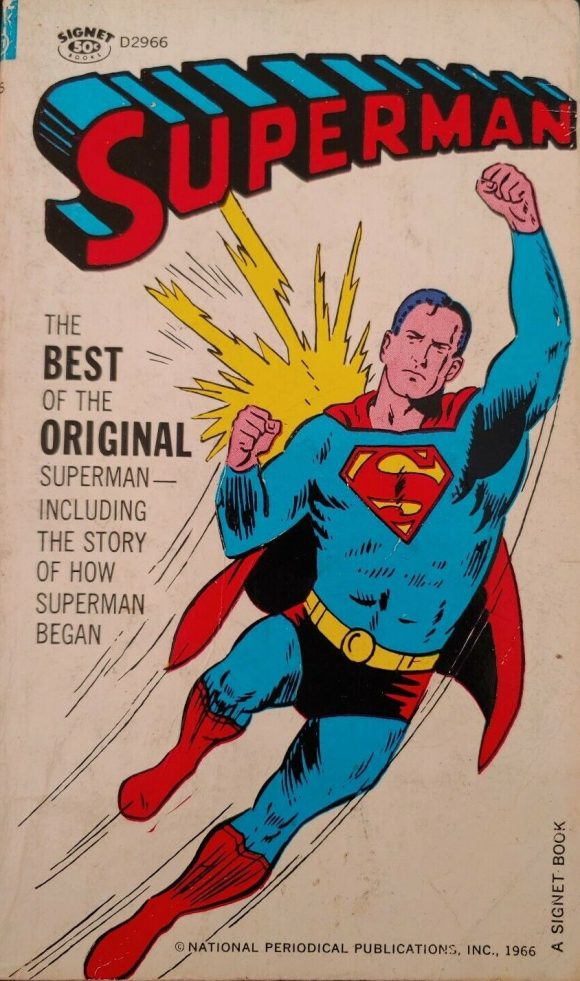
—
12. Marvel Comics Collector’s Albums (Lancer Books, 1966–1967). Marvel followed DC’s lead into the paperback book reprint market in 1966 with six black-and-white volumes. Like DC, they opted for the cut-and-paste rearrangement of the art to fit the smaller page, but the results here were even less satisfying.
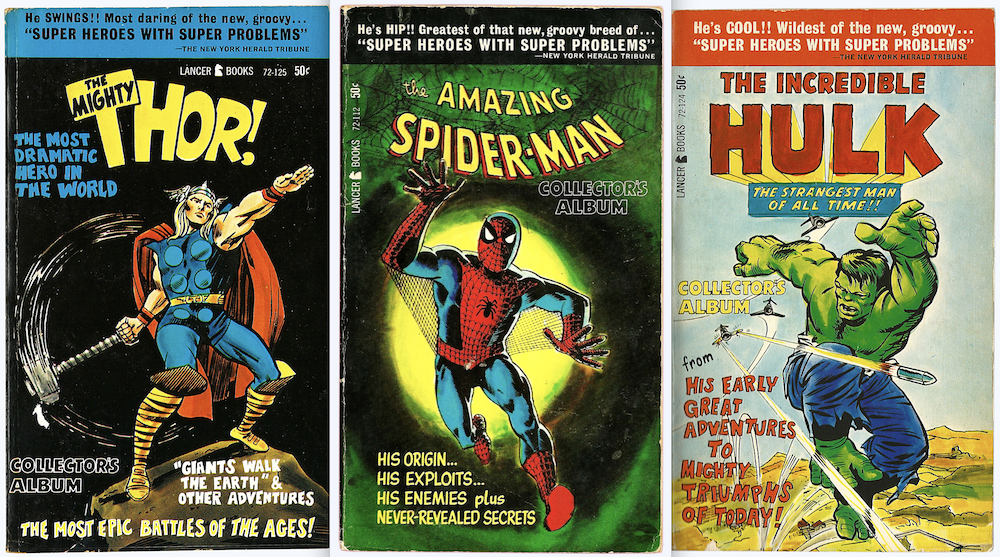
In addition to often making us turn the book on its side to read panels, they also edited out some splash pages. Still, in spite of their flaws, I gobbled them up: The Fantastic Four (reprinting FF #1, #6, #11), The Amazing Spider-Man (Amazing Spider-Man #1, #13, #16), The Incredible Hulk (Hulk #3 and Tales to Astonish #61, #62, #63), The Mighty Thor (Journey into Mystery #97, #104, #144, #145), The Fantastic Four Return (FF #33, #35 and Fantastic Four Annual #2), and Here Comes… Daredevil (#1, #3, #17).
—
13. The Fantastic Four in The House of Horrors, by William Johnston, art by Herb Trimpe and John Verpoorten (Whitman Big Little Book, 1968). One of some 1,000 Big Little Book titles published since 1932, these approximately 3.5” x 4.5” books could contain up to 432-pages of story and art (text on the left-hand page, captioned illustration on the right), and starred everything from movie stars (or their onscreen characters) to comic-strip and comic-book features (this and Spider-Man Zaps Mr. Zodiac were the only Marvel titles in the lot).
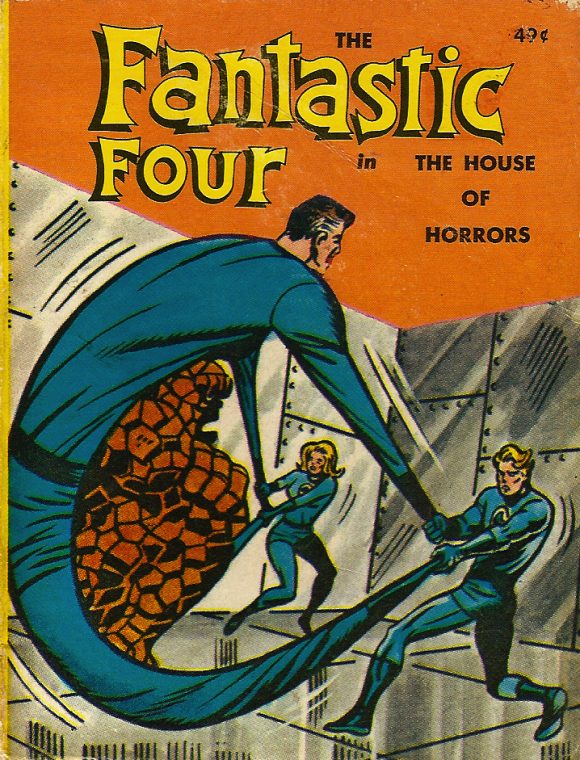
Ubiquitous pen-for-hire William Johnston wrote the story of the FF taking on Dr. Weird and his eponymous House of Horrors and seemed to have done his homework on Marvel’s flagship heroes. Newcomer Herb Trimpe penciled the full-page illustrations, very much in the style of Jack Kirby, and those were supplemented by actual panels by Kirby himself, lifted from the comics.
—
MORE
— PAUL KUPPERBERG: My 13 Favorite 1960s DC 80-PAGE GIANTS. Click here.
— PAUL KUPPERBERG: My 13 Favorite Comic Book Stories I’ve Written. Click here.

October 17, 2020
I have many of these in my collection. The BATMAN reprints were my favorite and I thought were lost treasures when found at the flea markets.
October 17, 2020
“Ted White had made the leap to professional and by the time he wrote The Great Gold Steal, he was already a Hugo-nominated author and respected science-fiction editor.”
Yes and in the late 70s when I encountered him at SF conventions I would tell him how much I enjoyed The Great Gold Steal and watch him squirm! (He didn’t enjoy being reminded of it.)
October 17, 2020
This is an incredibly solid article from Mr. Kupperberg. 🙂
October 18, 2020
I’ve got that Great Comic Book Heroes book by Jules Feiffer. I remember it well from my childhood. Just looked him up. Dude is still with us at 91. He’s just weeks older than my dad would have been today.
October 18, 2020
I have most of these and have had to replace a few over the years due to reading and re-reading my copies.
Looking forward to reading JSA Ragnarok
October 19, 2020
I, too, love that Captain America cover art.. but I do, and will always, hate the graphic design, with the text placed on either side of his head, but the reader is expected to read straight across. I do not understand how this is supposed to be readable by anyone on earth.
October 22, 2020
The Green Hornet TV show wasn’t camp at all. I don’t understand that comment.
October 25, 2020
I still have a bunch of these books. The Cap and Avengers novels were my favorites for the painted covers. It was a really good time to be a comic collecting kid.
April 11, 2021
The McGinnis cover for The Avengers Battle the Earth-Wrecker looks like he was instructed to make it look as much like a Doc Savage or Remo Williams as possible.
Also, look at the Scarlet Witch’s costume. It takes a special type of fabric to allow your belly button to show!
September 30, 2022
I got to re-read the “Captain Nice” book a while back and it was actually pretty funny! (The series wasn’t!) Johnston’s great comedic skill was funny dialogue and that makes this and the “Get Smart” books a blast!
July 25, 2023
Of Captain Nice, William Daniels recalled: ““Well, it had Buck Henry, and he would take a script, go into a room, and make it funny. He was a terribly gifted comic writer. But I can’t say as I remember too much about it except that once they flew me into the wall of the studio, and I banged my head!”